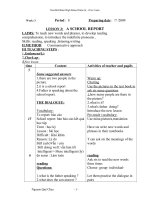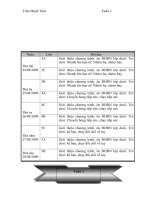Calculus 3 5: power series
Bạn đang xem bản rút gọn của tài liệu. Xem và tải ngay bản đầy đủ của tài liệu tại đây (227.79 KB, 31 trang )
Infinite Series and Differential Equations
Nguyen Thieu Huy
Hanoi University of Science and Technology
Nguyen Thieu Huy (HUST)
Infinite Series and Diff. Eq.
1/9
Differential Equations: Motivations
Falling Body Problems
Vertically falling body of mass m with unknown velocity v :
Two forces: 1) Gravitation mg ; 2) Air resistance: −kv , where k: positive
constant.
Nguyen Thieu Huy (HUST)
Infinite Series and Diff. Eq.
2/9
Differential Equations: Motivations
Falling Body Problems
Vertically falling body of mass m with unknown velocity v :
Two forces: 1) Gravitation mg ; 2) Air resistance: −kv , where k: positive
constant.
dv
v
Newton’s law: Ftotal = ma ⇔ mg − kv = m dv
dt ⇔ dt + k m = g
Nguyen Thieu Huy (HUST)
Infinite Series and Diff. Eq.
2/9
Electrical Circuits
RL-circuit consisting of a resistance R, inductor L, electromotive force E .
Let find the current I :
dI
Kirchoff’s Voltage Law: VR + VL = E . Also, VR = RI ; VL = L dt
.
Nguyen Thieu Huy (HUST)
Infinite Series and Diff. Eq.
3/9
Electrical Circuits
RL-circuit consisting of a resistance R, inductor L, electromotive force E .
Let find the current I :
dI
Kirchoff’s Voltage Law: VR + VL = E . Also, VR = RI ; VL = L dt
.
dI
dI
RI + L = E ⇔
+ RL I = E
dt
dt
Nguyen Thieu Huy (HUST)
Infinite Series and Diff. Eq.
3/9
Electrical Circuits
RL-circuit consisting of a resistance R, inductor L, electromotive force E .
Let find the current I :
dI
Kirchoff’s Voltage Law: VR + VL = E . Also, VR = RI ; VL = L dt
.
dI
dI
RI + L = E ⇔
+ RL I = E
dt
dt
2.1 Definition
A differential equation is an equation involving an unknown function and
its derivatives.
Nguyen Thieu Huy (HUST)
Infinite Series and Diff. Eq.
3/9
Basic Notions
Unknown function y :
• A differential equation is an
ordinary differential equation
if the unknown function depends on
only one independent variable.
Nguyen Thieu Huy (HUST)
Infinite Series and Diff. Eq.
4/9
Basic Notions
Unknown function y :
• A differential equation is an
ordinary differential equation
if the unknown function depends on
only one independent variable.
• If the unknown function depends
on two or more ind. variables,
then the differential equation is a
partial differential equation.
Nguyen Thieu Huy (HUST)
Infinite Series and Diff. Eq.
4/9
Basic Notions
Unknown function y :
• A differential equation is an
ordinary differential equation
if the unknown function depends on
only one independent variable.
• If the unknown function depends
on two or more ind. variables,
then the differential equation is a
partial differential equation.
• The order of a differential equation
is the order of the highest derivative
appearing in the equation.
Nguyen Thieu Huy (HUST)
Infinite Series and Diff. Eq.
4/9
Basic Notions
Unknown function y :
• A differential equation is an
ordinary differential equation
if the unknown function depends on
only one independent variable.
• If the unknown function depends
on two or more ind. variables,
then the differential equation is a
partial differential equation.
• The order of a differential equation
is the order of the highest derivative
appearing in the equation.
Abbreviation:
DE: Differential Equation
Nguyen Thieu Huy (HUST)
Infinite Series and Diff. Eq.
4/9
2.2 Definition: Solutions
A solution of a DE in the unknown function y and the ind. variable x on
the interval J ⊂ R is a function y (x) that satisfies the DE identically for
all x ∈ J. To solve a DE is to find all its solutions.
Nguyen Thieu Huy (HUST)
Infinite Series and Diff. Eq.
5/9
2.2 Definition: Solutions
A solution of a DE in the unknown function y and the ind. variable x on
the interval J ⊂ R is a function y (x) that satisfies the DE identically for
all x ∈ J. To solve a DE is to find all its solutions.
Example: The function y (x) = 2 sin 2x + 3 cos 2x is a solution to
y ” + 4y = 0 in (−∞, ∞).
Nguyen Thieu Huy (HUST)
Infinite Series and Diff. Eq.
5/9
2.2 Definition: Solutions
A solution of a DE in the unknown function y and the ind. variable x on
the interval J ⊂ R is a function y (x) that satisfies the DE identically for
all x ∈ J. To solve a DE is to find all its solutions.
Example: The function y (x) = 2 sin 2x + 3 cos 2x is a solution to
y ” + 4y = 0 in (−∞, ∞).
2.3 Definition: Particular and general solutions.
A particular solution of a DE is any one solution. The general solution of a
DE is the set of all its solutions.
Nguyen Thieu Huy (HUST)
Infinite Series and Diff. Eq.
5/9
2.2 Definition: Solutions
A solution of a DE in the unknown function y and the ind. variable x on
the interval J ⊂ R is a function y (x) that satisfies the DE identically for
all x ∈ J. To solve a DE is to find all its solutions.
Example: The function y (x) = 2 sin 2x + 3 cos 2x is a solution to
y ” + 4y = 0 in (−∞, ∞).
2.3 Definition: Particular and general solutions.
A particular solution of a DE is any one solution. The general solution of a
DE is the set of all its solutions.
2.4 Initial-Value and Boundary-Value Problems.
1 A DE with subsidiary conditions on the unknown function and its
derivatives, all given at the same value of the independent variable,
constitutes an initial-value problem.
Nguyen Thieu Huy (HUST)
Infinite Series and Diff. Eq.
5/9
2.2 Definition: Solutions
A solution of a DE in the unknown function y and the ind. variable x on
the interval J ⊂ R is a function y (x) that satisfies the DE identically for
all x ∈ J. To solve a DE is to find all its solutions.
Example: The function y (x) = 2 sin 2x + 3 cos 2x is a solution to
y ” + 4y = 0 in (−∞, ∞).
2.3 Definition: Particular and general solutions.
A particular solution of a DE is any one solution. The general solution of a
DE is the set of all its solutions.
2.4 Initial-Value and Boundary-Value Problems.
1 A DE with subsidiary conditions on the unknown function and its
derivatives, all given at the same value of the independent variable,
constitutes an initial-value problem. The sub. conditions are initial
conditions.
Nguyen Thieu Huy (HUST)
Infinite Series and Diff. Eq.
5/9
2.2 Definition: Solutions
A solution of a DE in the unknown function y and the ind. variable x on
the interval J ⊂ R is a function y (x) that satisfies the DE identically for
all x ∈ J. To solve a DE is to find all its solutions.
Example: The function y (x) = 2 sin 2x + 3 cos 2x is a solution to
y ” + 4y = 0 in (−∞, ∞).
2.3 Definition: Particular and general solutions.
A particular solution of a DE is any one solution. The general solution of a
DE is the set of all its solutions.
2.4 Initial-Value and Boundary-Value Problems.
1 A DE with subsidiary conditions on the unknown function and its
derivatives, all given at the same value of the independent variable,
constitutes an initial-value problem. The sub. conditions are initial
conditions.
2 If the sub. conditions are given at more than one value of the
independent variable, the problem is a boundary-value problem and
the sub. conditions are boundary conditions.
Nguyen Thieu Huy (HUST)
Infinite Series and Diff. Eq.
5/9
Example:
1
The problem y ” + 2y = x; y (π) = 1, y (π) = 2 is an initial value
problem, because the two subsidiary conditions are both given at
x = π.
Nguyen Thieu Huy (HUST)
Infinite Series and Diff. Eq.
6/9
Example:
1
The problem y ” + 2y = x; y (π) = 1, y (π) = 2 is an initial value
problem, because the two subsidiary conditions are both given at
x = π.
2
The problem y ” + 2y = x; y (0) = 1, y (1) = 1 is a boundary-value
problem, because the two subsidiary conditions are given at x = 0 and
x = 1.
Nguyen Thieu Huy (HUST)
Infinite Series and Diff. Eq.
6/9
Example:
1
The problem y ” + 2y = x; y (π) = 1, y (π) = 2 is an initial value
problem, because the two subsidiary conditions are both given at
x = π.
2
The problem y ” + 2y = x; y (0) = 1, y (1) = 1 is a boundary-value
problem, because the two subsidiary conditions are given at x = 0 and
x = 1.
2.5 Standard and Differential Forms
1 Standard form for a first-order DE in the unknown function y (x) is
y = f (x, y )
Nguyen Thieu Huy (HUST)
Infinite Series and Diff. Eq.
(1)
6/9
Example:
1
The problem y ” + 2y = x; y (π) = 1, y (π) = 2 is an initial value
problem, because the two subsidiary conditions are both given at
x = π.
2
The problem y ” + 2y = x; y (0) = 1, y (1) = 1 is a boundary-value
problem, because the two subsidiary conditions are given at x = 0 and
x = 1.
2.5 Standard and Differential Forms
1 Standard form for a first-order DE in the unknown function y (x) is
y = f (x, y )
2
(1)
The right side of (1) can always be written as a quotient of two other
M(x,y )
functions −M(x, y ) and N(x, y ). Then (1) becomes dy
dx = − N(x,y )
⇔ Differential form M(x, y )dx + N(x, y )dy = 0
Nguyen Thieu Huy (HUST)
Infinite Series and Diff. Eq.
(2)
6/9
FIRST-ORDER DIFFERENTIAL EQUATIONS
1. Separable Equations
1.1 Definition
The first-order separable differential equation has the form
A(x)dx + B(y )dy = 0
(3)
1.2 Solutions: The solution to (3) is
A(x)dx +
B(y )dy = c
(4)
where c represents an arbitrary constant.
Nguyen Thieu Huy (HUST)
Infinite Series and Diff. Eq.
7/9
FIRST-ORDER DIFFERENTIAL EQUATIONS
1. Separable Equations
1.1 Definition
The first-order separable differential equation has the form
A(x)dx + B(y )dy = 0
(3)
1.2 Solutions: The solution to (3) is
A(x)dx +
B(y )dy = c
(4)
where c represents an arbitrary constant.
x 2 +2
Example. Solve the equation: dy
dx = y .
Rewrite in the differential form (x 2 + 2)dx − ydy = 0 which is separable
with A(x) = x 2 + 2 and B(y ) = −y . Its solution is
(x 2 + 2)dx − ydy = c or 31 x 3 + 2x − 12 y 2 = c for any constant c.
Nguyen Thieu Huy (HUST)
Infinite Series and Diff. Eq.
7/9
FIRST-ORDER DIFFERENTIAL EQUATIONS
1. Separable Equations
1.1 Definition
The first-order separable differential equation has the form
A(x)dx + B(y )dy = 0
(3)
1.2 Solutions: The solution to (3) is
A(x)dx +
B(y )dy = c
(4)
where c represents an arbitrary constant.
x 2 +2
Example. Solve the equation: dy
dx = y .
Rewrite in the differential form (x 2 + 2)dx − ydy = 0 which is separable
with A(x) = x 2 + 2 and B(y ) = −y . Its solution is
(x 2 + 2)dx − ydy = c or 31 x 3 + 2x − 12 y 2 = c for any constant c.
Sometimes, it may not be algebraically possible to solve for y explicitly in
terms of x. In that case, the solution is left in implicit form.
Nguyen Thieu Huy (HUST)
Infinite Series and Diff. Eq.
7/9
1.3 Solutions to the Initial-Value Problem:
The solution to the initial-value problem A(x)dx + B(y )dy = 0; y (x0 ) = y0
can be obtained first by formula (4) and then substitute y (x0 ) = y0 to find
x
y
constant c, or another way is using x0 A(t)dt + y0 B(s)ds = 0.
Nguyen Thieu Huy (HUST)
Infinite Series and Diff. Eq.
8/9
1.3 Solutions to the Initial-Value Problem:
The solution to the initial-value problem A(x)dx + B(y )dy = 0; y (x0 ) = y0
can be obtained first by formula (4) and then substitute y (x0 ) = y0 to find
x
y
constant c, or another way is using x0 A(t)dt + y0 B(s)ds = 0.
2. Homogeneous Equations:
2.1 Definition:
A DE in standard form
dy
= f (x, y )
dx
is homogeneous if f (tx, ty ) = f (x, y ) for every real number t = 0.
Nguyen Thieu Huy (HUST)
Infinite Series and Diff. Eq.
(5)
8/9









